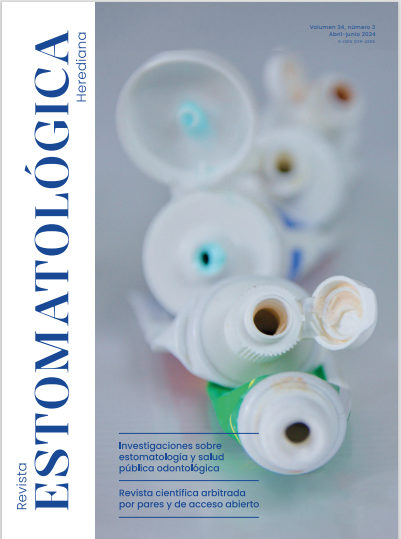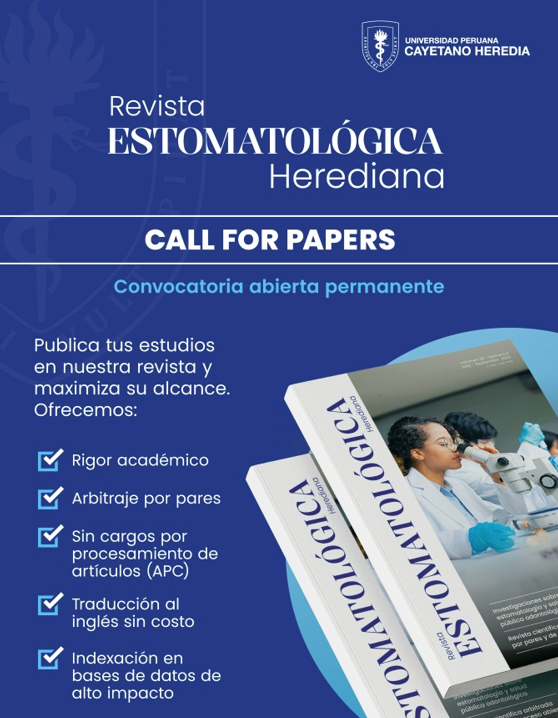Uso de pastas dentales en niños menores de 12 años en el Perú durante los años 2019-2021: un análisis multivariado
DOI:
https://doi.org/10.20453/reh.v34i2.5533Palabras clave:
dentrífico, niño, COVID-19Resumen
Objetivo: Determinar el uso de la pasta dental en niños peruanos menores de 12 años en el período 2019-2021. Materiales y métodos: Estudio transversal donde se utilizaron los registros de la Encuesta Demográfica y de Salud Familiar - ENDES (de 2019 a 2021) recopilándose información en salud bucal. Los resultados se examinaron según las variables de estudio y se realizó análisis estadísticos. Resultados: El 98,89% (n=81668) de niños peruanos menores de 12 años usaba pasta dental en el período 2019-2021, sin embargo, su uso disminuyó en el trascurso de los años, encontrándose diferencias estadísticamente significativas. El uso de pasta dental fluorada con un mínimo de 1000 ppm se incrementó con los años, hallándose diferencias estadísticamente significativas. En el análisis multivariado hubo una asociación positiva entre el año 2020 y uso de pasta dental fluorada con mínimo 1000 ppm (RPa=1,04; IC95%=1,01-1,07 y p=0,004). También se encontró asociación positiva entre el año 2021 y uso de pasta dental fluorada con un mínimo 1000 ppm (RPa=1,12; IC95%=1,10-1,15 y p<0,001). Conclusiones: Existe asociación entre el uso de pasta dental y año, región natural, área de residencia, lugar de residencia, altitud y edad; además entre el uso de pasta dental fluorada con mínimo 1000 ppm y año, región natural, área de residencia, lugar de residencia, índice de riqueza y edad.
Descargas
Citas
Pitts NB, Zero DT, Marsh PD, Ekstrand K, Weintraub JA, Ramos-Gomez F, et al. Dental caries. Nat Rev Dis Primers. 2017;25(3):17030.
Organización Mundial de la Salud. Salud bucodental. Ginebra: Organización Mundial de la Salud; 2022 (Consultado el 06 de junio del 2022). Disponible en: https://www.who.int/es/news-room/fact-sheets/detail/oral-health.
Suokko H, Tolvanen M, Virtanen J, Suominen A, Karlsson L, Karlsson H, et al. Parent's self-reported tooth brushing and use of fluoridated toothpaste: Associations with their one-year-old child's preventive oral health behaviour. Community Dent Oral Epidemiol. 2022;10.1111/cdoe.12742.
Walsh T, Worthington HV, Glenny AM, Marinho VCC, Jeroncic A. Fluoride toothpaste of different concentraciotions for preventing dental caries (Review). Cochrane Database of Systematic Reviews. 2019;3:1-242.
Kumar S, Tadakamadla J, Johnson NW. Effect of Toothbrushing frequency on incidence and increment of dental caries: A Systematic Review and Meta-Analysis. Journal of Dental Research 2016;95(11):1230-6.
Ministerio de Salud del Perú. Resolución Ministerial Nº 422-2017/MINSA. Guía Técnica: Guía de Práctica Clínica para la Prevención, Diagnóstico y Tratamiento de la Caries Dental en Niñas y Niños. Ministerio de Salud del Perú; 2017. (Consultado el 11 de junio del 2022). Disponible en: https://www.gob.pe/institucion/minsa/normas-legales/189474-422-2017-minsa
American Dental Association. ADA Interim Guidance for Minimizing Risk of COVID-19 Transmission. Illinois: American Dental Association; 2020 (Consultado 11 de Junio de 2022). Disponible en: https://snlg.iss.it/wpcontent/uploads/2020/04/ADA_COVID_Int_Guidance_Treat_Pts.pdf
Luzzi V, Ierardo G, Bossù M, Polimeni A. Paediatric Oral Health during and after the COVID-19 Pandemic. Int J Paediatr Dent. 2021;31(1):20-6.
Berhan Nordin EA, Shoaib LA, Mohd Yusof ZY, Manan NM, Othman SA. Oral health-related quality of life among 11–12 year old indigenous children in Malaysia. BMC Oral Health. 2019;19(1):152.
Martin M, Pugach O, Avenetti D, Lee H, Salazar S, Rosales G, Songthangtham N. Oral Health Behaviors in Very Young Children in Low-Income Urban Areas in Chicago, Illinois, 2018-2019. Prev Chronic Dis. 2020;17:E152.
Khan IM, Mani SA, Doss JG, Danaee M, Kong LYL. Pre-schoolers’ tooth brushing behaviour and association with their oral health: a cross sectional study. BMC Salud Bucal. 2021;21(1):283.
Idowu EA, Nwhator SO, Afolabi AO. Nigeria′s street children, epitome of oral health disparity and inequality. Pan Afr Med J. 2020; 9(36):77.
Anderson M, Dahllöf G, Warnqvist A, Grindefjord M. Development of dental caries and risk factors between 1 and 7 years of age in areas of high risk for dental caries in Stockholm, Sweden. Eur Arch Paediatr Dent. 2021 ;22(5) :947-57.
Lima CV, Pierote JJ, de Santana Neta HA, de Deus Moura de Lima M, de Deus Moura Lde F, de Moura MS. Caries, Toothbrushing Habits, and Fluoride Intake from Toothpaste by Brazilian Children According to Socioeconomic Status. Pediatr Dent. 2016;38(4):305-10.
Instituto Nacional de Estadística e Informática. Ficha Técnica-Encuesta Demográfica y de Salud Familiar. Instituto Nacional de Estadística e Informática; 2019. (Consultado el 30 de junio del 2022). Disponible en: https://proyectos.inei.gob.pe/endes/2019/documentos_2019/FICHA_TECNICA_ENDES%202019.pdf
Instituto Nacional de Estadística e Informática. Ficha Técnica-Encuesta Demográfica y de Salud Familiar. Instituto Nacional de Estadística e Informática; 2020. (Consultado el 30 de junio del 2022). Disponible en: https://proyectos.inei.gob.pe/endes/2020/documentos_2020/FICHA_TECNICA_ENDES%202020.pdf
Instituto Nacional de Estadística e Informática. Ficha Técnica-Encuesta Demográfica y de Salud Familiar. Instituto Nacional de Estadística e Informática; 2021. (Consultado el 30 de junio del 2022). Disponible en: https://proyectos.inei.gob.pe/endes/2021/DOCUMENTOS/FICHA_TECNICA_ENDES_2021.pdf
Wordley V, Lee H, Lomazzi M, Bedi R. The sugar tax – An opportunity to advance oral helath. British Dental Journal. 2017;223(1):11-12.
Goldman A, Yee R, Holgmgren C, Benzian H. Global affordability of fluoride toothpaste. Globalization and Health. 2008;4:7.
Arora A, Nargundkar S, Fahey P, Joshua H, John JR. Social determinants and behavioural factors influencing toothbrushing frequency among primary school children in rural Australian community of Lithgow, New South Wales. BMC Res Notes. 2020;13(1):403.
Jensen O, Gabre P, Sköld UM,Birkhed D. Is the use of fluoride toothpaste optimal? Knowledge, attitudes and behaviour concerning fluoride toothpaste and toothbrushing in different age groups in Sweden. Community Dent Oral Epidemiol 2012;40:175-184.
Díaz A, Torres G, Pérez L, Chein S, Andia M, Castañeda S, Arieta J, Ruíz K, López R, Ramírez L, Apaza S, Blanco D, Arce C, Orihuela J. E. Uso de crema dental en niños peruanos menores de 12 años durante el periodo del 2016 - 2018. Resultados de una encuesta nacional. Odontol Pediatr 2020;19(2);5-12.
Avenetti D, Lee HH, Pugach O, Rosales G, Sandoval A, Martin M. Tooth Brushing Behaviors and Fluoridated Toothpaste Use Among Children Younger Than Three Years Old in Chicago. J Dent Child (Chic). 2020;87(1):31-38.
Buckeridge A, King N, Anthonappa R. Relationships between parental education, choice of child dentifrice, and their children's caries experience. Int J Paediatr Dent. 2021;31(1):115-121.
Garcés-Elías M, Del Castillo-López C, Beltrán J, Agudelo-Suárez A, León-Manco R. Toothpaste use in peruvian children during COVID-19 pandemic: results from a National Demographic and Health Survey. European Archives of Paediatric Dentistry. 2023;24:779-786.
Aiuto R, Dioguardi M, Caruso S, Lipani E, Re D, Gatto R, Garcovich D. What Do Mothers (or Caregivers) Know about Their Children's Oral Hygiene? An Update of the Current Evidence. Children (Basel). 2022;9(8):1215.
Chávez BA, Vergel GB, Cáceres CP, Perazzo MF, Vieira-Andrade RG, Cury JA. Fluoride content in children's dentifrices marketed in Lima, Peru. Braz Oral Res. 2019;33:E51.
Jamieson L, Gibson B, Thomson WM. Oral Health Inequalities and the Corporate Determinants of Health: A Commentary. Int J Environ Res Public Health. 2020;17(18):6529.
Maani N, Collin J, Friel S, et al. Bringing the commercial determinants of health out of the shadows: a review of how the commercial determinants are represented in conceptual frameworks. Eur J Public Health. 2020;30(4):660-664.
de Lacy-Vawdon C, Livingstone C. Defining the commercial determinants of health: a systematic review. BMC Public Health. 2020;20(1):1022.
Martins CC, Oliveira MJ, Pordeus IA, Cury JA, Paiva SM. Association between socioeconomic factors and the choice of dentifrice and fluoride intake by children. Int J Environ Res Public Health. 2011;8(11):4284-4299.
Salamá F, Alwohaibi A, Alabdullatif A, Alnasser A, Hafiz Z. Knowledge, behaviours and beliefs of parents regarding the oral health of their children. Eur J Paediatr Dent. 2020;21(2):103-109.
Trinh VA, Tarbit E, Do L, Ha D, Tadakamadla SK. The influence of family socioeconomic status on toothbrushing practices in Australian children. J Public Health Dent. 2021 Dec;81(4):308-315.
Descargas
Publicado
Cómo citar
Número
Sección
Licencia
Derechos de autor 2024 Revista Estomatológica Herediana

Esta obra está bajo una licencia internacional Creative Commons Atribución 4.0.
Los autores conservan los derechos de autor y ceden a la revista el derecho de primera publicación, con el trabajo registrado con la Licencia de Creative Commons, que permite a terceros utilizar lo publicado siempre que mencionen la autoría del trabajo, y a la primera publicación en esta revista.
























